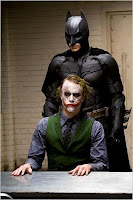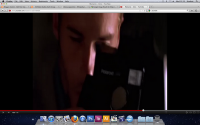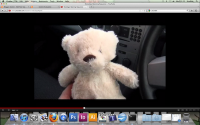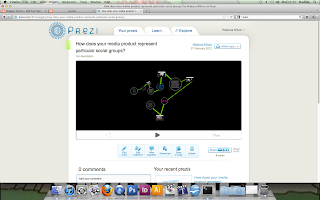Conventions we used


In our thriller film, Nostalgia, we used many different conventions including the binary opposition convention. This was shown between the two main characters - Dominic Christoper (the antagonist) and Detective Vince Clarke (the protagonist) mainly through Mise-
En-Scene as the costumes the characters wore were typical outfits that the audience would imagine them in. Dominic wore a hoodie and tracksuit bottoms which automatically made the audience think that he was of a lower class and could possibly be causing trouble as he wore his hood up.
However, Vince on the other hand was seen to be wearing a suit which gave the impression that he had a good job and was of a higher class than Christopher.
The binary opposition is also used in the film The Dark Knight where Batman plays the protagonist and the Joker is the antagonist. However in this film, the Mise-En-Scene aspect is the opposite to our thriller film as the costumes Batman and Joker are to be seen wearing tell the opposite of what their character is like. As Batman is dressed in a dark, black bat outfit, the audience may think of him to be the antagonist at the start of the film. Whereas the Joker is dressed as a clown but with a slightly scary aspect to it as his face is made to look more evil-like.
 |
| Credits from our film, Nostalgia |
 |
| Credits from the film Se7en |
Conventions we developed
 The use of time was a convention that we developed for effect. We did this through repeatedly adding flashbacks into scenes. These we flashbacks of the Detectives daughter, Alice. This made the audience question as to whether Alice was alive or not as certain things would trigger off these flashbacks. For example when Vince looks at the teddy bear on the dashboard, it triggers a flashback as the teddy reminds him of Alice. The next time this happens is when the Detective runs past a mother with her daughter which leads to him loosing the antagonist as he remembers Alice talking to him in the forest. This helps the audience to empathise towards Vince as well as making them nervous as they don't want him to loose Dominic.
The use of time was a convention that we developed for effect. We did this through repeatedly adding flashbacks into scenes. These we flashbacks of the Detectives daughter, Alice. This made the audience question as to whether Alice was alive or not as certain things would trigger off these flashbacks. For example when Vince looks at the teddy bear on the dashboard, it triggers a flashback as the teddy reminds him of Alice. The next time this happens is when the Detective runs past a mother with her daughter which leads to him loosing the antagonist as he remembers Alice talking to him in the forest. This helps the audience to empathise towards Vince as well as making them nervous as they don't want him to loose Dominic.
The film Memento 's use of time is an excellent way of developing time as the beginning scene is actually the ending. This way, it keeps the audience thinking about what is going to happen in the lead up to it and why it has happened. There are similarities between this film and our film, Nostalgia as we also make our audience question when and were different scenes in our film are set.
 Another convention we developed was that we had an aspect of drama in our opening scenes. As well as being a thriller film, we also focused the film around the relationship the Detective had with his daughter. For the audience, these scenes became easy to relate to and therefore the audience were able to empathise with the Detective. This is shown especially when Vince has a flashback as it helps the audience to understand what he is going through more and how his daughter meant the world to him as he still keeps her teddies in his car which always remind him of her.
Another convention we developed was that we had an aspect of drama in our opening scenes. As well as being a thriller film, we also focused the film around the relationship the Detective had with his daughter. For the audience, these scenes became easy to relate to and therefore the audience were able to empathise with the Detective. This is shown especially when Vince has a flashback as it helps the audience to understand what he is going through more and how his daughter meant the world to him as he still keeps her teddies in his car which always remind him of her. Using a drama aspect in a thriller film was also shown in the film I Am Legend which focuses on the relationship the main character, Robert has with his dog. This relationship is shown up until Robert has to kill his dog, which is emotional for both the audience and Robert. This helps the audience to identify and to relate to what kind of character Robert is and what sort of life he leads.
Using a drama aspect in a thriller film was also shown in the film I Am Legend which focuses on the relationship the main character, Robert has with his dog. This relationship is shown up until Robert has to kill his dog, which is emotional for both the audience and Robert. This helps the audience to identify and to relate to what kind of character Robert is and what sort of life he leads.Conventions we challenged
 Establishing shots was the convention our thriller film challenged. We chose not to use an establishing shot as we felt that for the audience, the feeling of not knowing where abouts the forest was helped to not only create tension but also made them feel uncomfortable as the Detective didn't know where Dominic had disappeared to which creates a feeling of nervousness.
Establishing shots was the convention our thriller film challenged. We chose not to use an establishing shot as we felt that for the audience, the feeling of not knowing where abouts the forest was helped to not only create tension but also made them feel uncomfortable as the Detective didn't know where Dominic had disappeared to which creates a feeling of nervousness.The film Seeking Justice also chose not to use an establishing shot as they wanted to leave the location unknown and make the audience focus on the female character and what is about to happen. This is exactly what our film, Nostalgia focuses on as it makes the audience guess where abouts the scene is set - whether it is a place close to the audience or familiar to them.
2. How does your media product represent particular social groups?
3. What kind of media institution might distribute your media product and why?
http://nostalgia2012.wikispaces.com/
4. Who would be the audience for your media product?
His name is Tom, he is 22 years old and is currently studying law. He lives with his two friends in Cambridge and goes to the cinema once a month. He owns a large collection of DVDs including the CSI box set as he enjoys watching thriller/detective crime films and programmes.


 Tom is a part time manager at a restaurant outside of Cambridge and is currently saving up for his own house in London for when he starts his job as a lawyer there. As he is saving for a house, he tends not to go out as much as he used to so regularly streams films from the internet. He enjoys cooking and reading and in his spare time helps coach rugby. Tom doesn't like watching soaps or going clubbing - he would rather stay in and watch a film.
Tom is a part time manager at a restaurant outside of Cambridge and is currently saving up for his own house in London for when he starts his job as a lawyer there. As he is saving for a house, he tends not to go out as much as he used to so regularly streams films from the internet. He enjoys cooking and reading and in his spare time helps coach rugby. Tom doesn't like watching soaps or going clubbing - he would rather stay in and watch a film.Tom may seem to not be very wealthy when actually he has recently inherited a large sum of money that he has put towards buying a house in London. He has always been very careful with money and would rather save it than spend it on a night out in the pub or going out for a meal. However, he has always taken a big interest into films. His favourite film is The Silence of the Lambs as it is a thriller which includes a detective. Films like this are what made Tom want to be a law student in the first place. Tom has many beliefs and values. Independence, making a difference, success, loyalty and optimism are a few of his values. He believes that failure is good and that hard work and perseverance are rewarded. Tom is his own person and doesn't follow the crowd and doesn't always do what his friends do.
5. How did you attract/address your audience?
6. What have you learnt about technologies from the process of constructing this product?
Blogger
Before the process of constructing our product, I had never used Blogger before. I found it fairly easy to use however it took me a while to remember how to add youtube videos and prezi presentations into the post as I always forgot to use the 'Edit HTML' option.
YouTube
Even though I had used YouTube before to watch music videos and other clips, I had never uploaded a video or added annotations to it. After learning how to upload a video and annotate it, I found it quite easy to do.
Prezi
 I had never heard of Prezi before this process. I found it very confusing and complicated to use at the start, however after I discovered how to do the basics it became clear how to make a presentation. I created a Prezi as part of my evaluation of how our product represents particular social groups. I found this an effective and modern way to present my work.
I had never heard of Prezi before this process. I found it very confusing and complicated to use at the start, however after I discovered how to do the basics it became clear how to make a presentation. I created a Prezi as part of my evaluation of how our product represents particular social groups. I found this an effective and modern way to present my work.Final Cut Express
This was my first time using Final Cut Express. I found it very difficult and complicated to use at the beginning but after playing around with it and with some help I understood how it works and learnt the basics of how to edit our film.
7. Looking back at your preliminary task, what do you feel you learnt in the progression from it to the full product?
Here is our edited preliminary task. We added annotations which shows our use of camera shots as well as props and editing. This helped us improve our opening to Nostalgia as it allowed us to prepare and practise editing and filming.
.jpg)

















